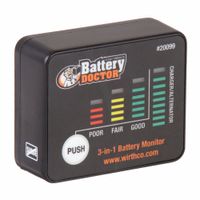Call +(254) 703 030 000 / 751 483 999 / 721 704 777
Battery Protection
Battery boxes protect batteries against impact, weather, gasoline, and oil. They hold batteries in place and contain leakage from damaged batteries. Boxes fit specific battery group size or multiple sizes and require adequate ventilation. The box may have a carry handle, or hold more than one batter .....Read More
Frequently Asked Questions
What is the purpose of a battery box?
A battery box serves several critical purposes, primarily related to the protection, organization, and functionality of batteries. Firstly, it provides physical protection to the batteries, shielding them from environmental factors such as moisture, dust, and physical impacts, which can lead to damage or reduced performance. This is particularly important in outdoor or mobile applications, such as in boats, RVs, or off-grid solar systems.
Secondly, a battery box ensures safety by containing any potential leaks or spills of battery acid, which can be hazardous. It often includes features like ventilation to prevent the buildup of potentially explosive gases emitted by certain types of batteries, such as lead-acid batteries.
Additionally, a battery box aids in the organization and secure mounting of batteries, preventing them from moving or tipping over, which could cause short circuits or other damage. This is especially crucial in vehicles or other mobile applications where movement is frequent.
Moreover, battery boxes often come with integrated features such as terminal connections, circuit breakers, or fuses, which facilitate easier and safer electrical connections. This can simplify the process of connecting batteries to a system and provide additional layers of electrical safety.
In some cases, battery boxes are designed to be aesthetically pleasing, helping to conceal batteries and associated wiring, contributing to a cleaner and more organized appearance in residential or commercial settings.
Overall, the purpose of a battery box is to enhance the safety, longevity, and efficiency of battery systems by providing protection, organization, and additional functionality.
How do battery boxes protect against weather and impact?
Battery boxes protect against weather and impact through several design features:
1. **Material**: Battery boxes are typically made from durable materials like high-density polyethylene (HDPE) or polypropylene, which are resistant to UV rays, corrosion, and temperature fluctuations. This ensures the box can withstand harsh weather conditions without degrading.
2. **Sealing**: Many battery boxes have tight-sealing lids with gaskets or rubber seals to prevent water ingress. This keeps the battery dry and safe from rain, snow, and humidity, which can cause corrosion or short-circuiting.
3. **Ventilation**: While sealed, battery boxes often include ventilation features to allow gases produced by the battery to escape safely, preventing pressure build-up and reducing the risk of explosion.
4. **Impact Resistance**: The robust construction of battery boxes provides a protective barrier against physical impacts. The thick walls and reinforced corners absorb shocks and prevent damage to the battery from accidental drops or collisions.
5. **Mounting and Securing**: Battery boxes often come with mounting brackets or straps to secure them in place, minimizing movement and vibration during transport or in turbulent conditions, which can otherwise lead to physical damage or disconnection.
6. **Design**: The design of battery boxes often includes features like raised bases to keep the battery off the ground, preventing water pooling and enhancing protection against flooding.
7. **Insulation**: Some battery boxes include insulation to protect the battery from extreme temperatures, ensuring optimal performance and longevity by maintaining a stable internal environment.
These features collectively ensure that battery boxes provide comprehensive protection against environmental and physical threats, safeguarding the battery's functionality and lifespan.
What sizes do battery boxes come in?
Battery boxes come in a variety of sizes to accommodate different types and sizes of batteries. Common sizes include:
1. **Group U1**: Typically used for small lawn and garden equipment batteries.
2. **Group 24**: Suitable for smaller automotive and marine batteries.
3. **Group 27**: Often used for larger automotive, marine, and RV batteries.
4. **Group 31**: Designed for heavy-duty applications, such as commercial trucks and large marine batteries.
5. **6-Volt**: Specifically for 6-volt batteries, often used in golf carts and some RVs.
6. **8D**: For very large batteries used in industrial and commercial applications.
7. **Custom Sizes**: Some manufacturers offer custom-sized boxes for unique applications.
Battery boxes are also available in different configurations, such as single or dual battery setups, and can be made from materials like plastic or metal, depending on the application and environmental conditions.
Do battery boxes require ventilation?
Yes, battery boxes require ventilation. Ventilation is crucial for several reasons:
1. **Gas Emission**: Batteries, especially lead-acid types, can emit hydrogen gas during charging. Hydrogen is highly flammable, and without proper ventilation, it can accumulate and pose an explosion risk.
2. **Heat Dissipation**: Batteries generate heat during operation and charging. Adequate ventilation helps dissipate this heat, preventing overheating, which can lead to reduced battery life or failure.
3. **Corrosion Prevention**: Ventilation helps in reducing the accumulation of corrosive gases and vapors, which can damage battery terminals and connections over time.
4. **Safety Standards Compliance**: Many safety standards and regulations require battery enclosures to have proper ventilation to ensure safe operation and maintenance.
5. **Performance Optimization**: Proper ventilation ensures that batteries operate within their optimal temperature range, enhancing performance and efficiency.
In summary, ventilation in battery boxes is essential for safety, performance, and longevity.
Can battery boxes hold multiple batteries?
Yes, battery boxes can hold multiple batteries. Battery boxes are designed to house and protect batteries from environmental factors such as moisture, dust, and physical damage. They come in various sizes and configurations to accommodate different types and numbers of batteries.
For instance, some battery boxes are specifically designed to hold a single battery, while others are built to accommodate multiple batteries in series or parallel configurations. These multi-battery boxes are commonly used in applications requiring higher voltage or capacity, such as in marine, RV, solar power systems, and backup power solutions.
The design of a multi-battery box typically includes features like individual compartments or dividers to securely hold each battery in place, preventing movement and potential damage. They may also include terminals or connectors to facilitate easy wiring and connection of the batteries. Additionally, some battery boxes come with built-in ventilation to prevent overheating and features like handles or straps for easy transportation.
When selecting a battery box for multiple batteries, it is important to consider factors such as the size and type of batteries being used, the total weight, and the intended application to ensure compatibility and safety.
What additional features might a battery box have for vehicles like tractor trailers?
A battery box for vehicles like tractor trailers might include the following additional features:
1. **Thermal Management System**: To maintain optimal battery temperature, preventing overheating or freezing, which can affect performance and lifespan.
2. **Robust Enclosure**: Durable, weather-resistant materials to protect against harsh environmental conditions, including water, dust, and impact.
3. **Integrated Charging System**: Built-in charging capabilities for convenience, allowing for easy connection to external power sources.
4. **Battery Monitoring System**: Real-time monitoring of battery health, charge levels, and performance metrics, with alerts for maintenance or issues.
5. **Modular Design**: Flexibility to accommodate different battery sizes and configurations, allowing for easy upgrades or replacements.
6. **Safety Features**: Overcharge protection, short-circuit prevention, and thermal runaway mitigation to ensure safe operation.
7. **Connectivity Options**: Wireless or wired connectivity for integration with vehicle telematics systems, enabling remote monitoring and diagnostics.
8. **Locking Mechanism**: Secure locking systems to prevent unauthorized access or theft of the batteries.
9. **Vibration Dampening**: Features to minimize the impact of road vibrations, protecting the battery from physical damage.
10. **Easy Access Design**: User-friendly design for quick and easy access to batteries for maintenance or replacement.
11. **Energy Management System**: Intelligent energy distribution to optimize power usage and extend battery life.
12. **Compatibility with Renewable Energy**: Options for integration with solar panels or other renewable energy sources for sustainable power solutions.
13. **Emergency Power Supply**: Backup power capabilities to support critical systems in case of primary battery failure.
14. **Visual Indicators**: LED indicators or displays for quick status checks and diagnostics.
15. **Customizable Options**: Tailored features to meet specific operational needs or regulatory requirements.
What are alternative methods for battery protection?
1. **Battery Management Systems (BMS):** A BMS monitors the state of the battery, including voltage, current, and temperature, to prevent overcharging, over-discharging, and overheating.
2. **Thermal Management Systems:** These systems use cooling techniques such as liquid cooling, air cooling, or phase change materials to maintain optimal battery temperature and prevent thermal runaway.
3. **Fuses and Circuit Breakers:** These devices provide overcurrent protection by interrupting the flow of electricity in case of a short circuit or excessive current draw.
4. **Current Limiters:** These components restrict the amount of current that can flow into or out of the battery, preventing damage from excessive current.
5. **Voltage Regulators:** These devices ensure that the battery operates within a safe voltage range by stepping down or stepping up the voltage as needed.
6. **Cell Balancing:** This technique ensures that all cells in a battery pack are charged and discharged evenly, preventing individual cells from becoming overcharged or over-discharged.
7. **Solid-State Batteries:** These batteries use solid electrolytes instead of liquid ones, reducing the risk of leakage and improving safety.
8. **Protective Coatings:** Applying coatings to battery components can prevent corrosion and physical damage, enhancing durability and safety.
9. **Smart Charging Algorithms:** These algorithms optimize the charging process by adjusting the charging rate and duration based on the battery's state of health and environmental conditions.
10. **Physical Barriers:** Incorporating barriers within the battery pack can prevent the spread of thermal events from one cell to another.
11. **Pressure Relief Valves:** These valves release excess pressure from within the battery, preventing rupture or explosion.
12. **Fire Suppression Systems:** These systems detect and extinguish fires within battery packs, minimizing damage and risk.



